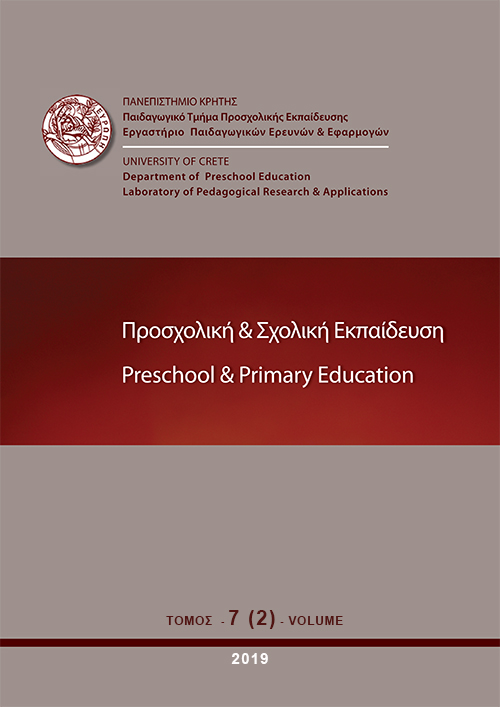Ανάπτυξη και ψυχομετρική επικύρωση κλίμακας αυτοαναφοράς στρατηγικών αναγνωστικής κατανόησης για δίγλωσσους μαθητές

Περίληψη
Η παρούσα εργασία περιγράφει την ανάπτυξη και την ψυχομετρική επικύρωση μιας κλίμακας αυτοαναφοράς για την εκτίμηση της χρήσης στρατηγικών αναγνωστικής κατανόησης από δίγλωσσους μαθητές ηλικίας 9 έως 12 ετών. Ο ψυχομετρικός έλεγχος του εργαλείου που κατασκευάστηκε περιλάμβανε εξέταση της εγκυρότητας της εννοιολογικής του κατασκευής και αξιοπιστίας σε δείγμα 247 δίγλωσσων μαθητών δημοτικού σχολείου με τα Ελληνικά ως δεύτερη γλώσσα. Από τους παραπάνω ελέγχους προέκυψε μια αξιόπιστη και αξιολογήσιμη δομή δεκαεννιά ερωτήσεων και τεσσάρων παραγόντων, η οποία περιλαμβάνει ως συστατικά στοιχεία το κριτήριο των γνωστικών στρατηγικών, των μεταγνωστικών, των κοινωνικών και των συναισθηματικών στρατηγικών αναγνωστικής κατανόησης. Τέλος, παρέχονται οδηγίες για τη βαθμολόγηση του εργαλείου και προτείνονται τρόποι ερμηνείας των αποτελεσμάτων του.
Λεπτομέρειες άρθρου
- Πώς να δημιουργήσετε Αναφορές
-
Μαστροθανάσης Κ. (2019). Ανάπτυξη και ψυχομετρική επικύρωση κλίμακας αυτοαναφοράς στρατηγικών αναγνωστικής κατανόησης για δίγλωσσους μαθητές. Preschool and Primary Education, 7(2), 116–138. https://doi.org/10.12681/ppej.20212
- Τεύχος
- Τόμ. 7 Αρ. 2 (2019)
- Ενότητα
- Άρθρα

Αυτή η εργασία είναι αδειοδοτημένη υπό το CC Αναφορά Δημιουργού – Μη Εμπορική Χρήση – Παρόμοια Διανομή 4.0.
Οι συγγραφείς των άρθρων που δημοσιεύονται στο ΠΡΟΣΧΟΛΙΚΗ & ΣΧΟΛΙΚΗ ΕΚΠΑΙΔΕΥΣΗ διατηρούν τα δικαιώματα πνευματικής ιδιοκτησίας επί των άρθρων τους, δίνοντας στο περιοδικό το δικαίωμα της πρώτης δημοσίευσης. Άρθρα που δημοσιεύονται στο ΠΡΟΣΧΟΛΙΚΗ & ΣΧΟΛΙΚΗ ΕΚΠΑΙΔΕΥΣΗ διατίθενται με άδεια Creative Commons 3.0 και σύμφωνα με την άδεια μπορούν να χρησιμοποιούνται ελεύθερα, με αναφορά στο/στη συγγραφέα και στην πρώτη δημοσίευση για μη κερδοσκοπικούς σκοπούς και με δικαίωμα τροποποίησης μόνον με παρόμοια διανομή (αν αναμείξετε, τροποποιήσετε, ή δημιουργήσετε πάνω στο υλικό, πρέπει να διανείμετε τις δικές σας συνεισφορές υπό την ίδια άδεια όπως και το πρωτότυπο). To Εργαστήριο Παιδαγωγικών Ερευνών και Εφαρμογών του Παιδαγωγικού Τμήματος Προσχολικής Εκπαίδευσης του Πανεπιστημίου Κρήτης και το Εθνικό Κέντρο Τεκμηρίωσης διατηρούν το δικαίωμα να δημοσιεύουν, να αναπαραγάγουν, να παρουσιάζουν στο κοινό, να διανέμουν και χρησιμοποιούν άρθρα που δημοσιεύονται στο ΠΡΟΣΧΟΛΙΚΗ & ΣΧΟΛΙΚΗ ΕΚΠΑΙΔΕΥΣΗ σε οποιοδήποτε μέσο και μορφή είτε μεμονωμένα είτε ως μέρη συλλογικών έργων, για όλο το χρόνο διάρκειας προστασίας της πνευματικής ιδιοκτησίας και για όλες τις χώρες του κόσμου. Αυτό περιλαμβάνει ενδεικτικά και όχι αποκλειστικά, το δικαίωμα δημοσίευσης των άρθρων σε τεύχη του περιοδικού ΠΡΟΣΧΟΛΙΚΗ & ΣΧΟΛΙΚΗ ΕΚΠΑΙΔΕΥΣΗ, αναπαραγωγής και διανομής μεμονωμένων αντιγράφων των άρθρων, αναπαραγωγής ολόκληρων των άρθρων σε άλλη έκδοση του Εργαστηρίου Παιδαγωγικών Ερευνών και Εφαρμογών του Παιδαγωγικού Τμήματος Προσχολικής Εκπαίδευσης του Πανεπιστημίου Κρήτης και του Εθνικού Κέντρου Τεκμηρίωσης και αναπαραγωγής και διανομής των άρθρων ή περίληψης αυτών με χρήση πληροφορικού συστήματος αποθετηρίου.


